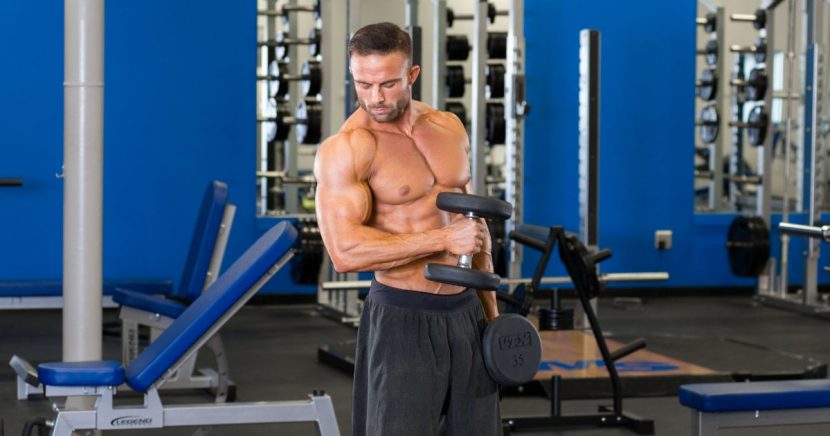Mona Noyes, 86, works out with trainer Emily Socolinsky at Fivex3 Training in Baltimore. (Kyna Uwaeme for NPR) BALTIMORE — On a recent weekday morning, weightlifter Mona Noyes walks up to a platform and positions herself to deadlift, with the help of a trainer. At just over 5 feet tall with curled white hair, this […]


BALTIMORE — On a recent weekday morning, weightlifter Mona Noyes walks up to a platform and positions herself to deadlift, with the help of a trainer. At just over 5 feet tall with curled white hair, this 86-year-old knows what she’s doing at the gym.
For most of her adult life, Noyes was active and worked as a school administrator. She loved her job. Still, when Noyes retired at 77, she felt embarrassed to be “the oldest person anywhere.” And once she stopped working, she also stopped moving. She pulled back from travel and meeting new people, wondering, “Is it safe? Can I really do that?”
Strength training can help people stay healthy as they age. It can slow age-related muscle mass and strength loss, help maintain bone density and improve stability.
But getting started can be intimidating.
Noyes said her confidence dropped when she stopped moving her body. Then her daughter suggested she try working out with a trainer at her gym.
“I thought, well, you know what? I’ll try it. And then I can say, ‘OK, I tried it. That’s it. We’re done.’ But I never went away,” she said.

And that’s how Noyes ended up at Fivex3 Training, a strength and conditioning gym in Baltimore, where she works with coach and trainer Emily Socolinsky. NPR’s Juana Summers was briefly a Fivex3 Training member in 2018.
At first, Noyes started small — stepping up on a box to better handle the stairs. As she continued working with Socolinsky, Noyes got stronger. She says strength training made daily activities easier: from carrying grocery bags to standing up from a low toilet seat.
“Who wants to go to a strange place and you can’t get off the john, you know, and things like that?”
Noyes had tried other gyms, with lots of machines, where she says she saw “sexy workout clothes and lithe bodies.” Her experience at this gym is different. The gym equipment is simple. Several mornings a week are reserved for more senior athletes. And everyone we met at the gym mentioned one critical element: individual attention from a coach who knows you.

A gym with a mission
Socolinsky, 50, never planned to open a gym. But after years of professional dancing, her back was in tatters: slipped discs, arthritis and degenerative disease. Socolinsky remembers one morning as she was brushing her teeth her whole back seized up and she fell to the floor. She was 35.
Strength training, Socolinsky says, gave her freedom from pain and gave her her mobility back. She had imagined she might someday open a dance studio, but after a weekend seminar on coaching strength training, she was hooked. And her dreams changed.
“I knew immediately … that I wanted to open a gym,” says Socolinsky. “I wanted to work with adults, and I wanted to do what it did for me. I want to help them and make them better.”
So that’s what she did. When Socolinsky first opened her gym, she didn’t target a particular age group. But over time, that changed.
“By 2016, it was quite clear I was really enjoying my older clients and I was seeing a bigger push for older people to train,” she said.
Current clients brought their friends and adult children referred their parents.
72-year-old Jack LeDonne has been training here for more than 3 years. As a retired surgeon, LeDonne says he knew what the literature said about the benefits of weight training, but it wasn’t a part of his routine until his son introduced him to Socolinsky.
“And then, you know, strange thing happens,” LeDonne says. “You get into it, you know, it becomes part of your discipline.”

Socolinsky’s mom, Joanne Giza, who is 75, also works out at this gym. Giza has been focusing on squats and presses to help with her posture. Giza says she used to hate exercise and hate sweating. But like so many people we met at Fivex3 Training, her daughter — in this case, the gym owner — persuaded her to start lifting, and Giza began to see the benefits.
“It’s just easier to do everything that you need to do on a daily basis,” Giza says. Like lifting a bag of dog food. “The aches and pains are still there, but I can do it more easily.”

69-year-old Esther Rechthand works out nearby. She joined about 4 years ago. Rechthand has osteopenia. She credits strength training for improving her bone density score.
“I’m still going to come because it’s just, it feels good,” Rechthand says. “It just feels really good.”
Becca Jordre, a professor of physical therapy at the University of South Dakota, studies active older adults. She says the benefits of regular exercise are profound at every age, and at every age, bodies need to be pushed through exercise.
“If the signal is: I’m going to sit in my chair and I’m not going to walk very far, our body will adjust — we’ll lose muscle mass and bone density,” Jordre says.
That can leave people unprepared for occasional movements, like a jump or pushing something heavy. But with regular exercise, the body can adapt.
“It is just as possible with older adults as it is with younger individuals,” says Jordre.
And that’s what we found at Fivex3 Training, where older adults talk about doing things like moving furniture, getting easily in and out of vehicles, and carrying groceries.

“This is the best thing you [can] do for yourself, and then all the people around you,” says Noyes. “Because you keep functioning.”
And not only that, her world has expanded. She now feels confident in her body. And that speaks to Socolinsky’s number one goal for her clients — quality of life.
“The worst thing that you can do is stop [moving],” Socolinsky says. “When they start a program like this … they stand taller. They walk with more purpose … because in the back of their mind, they know what they’re capable of doing in the gym.”
Transcript:
JUANA SUMMERS, HOST:
This week, we’re bringing you stories about people who are staying active as they age – from the pickleball court to the pool. Today, we’re headed to a gym in Baltimore, where the owner says strength training is key to aging well.
EMILY SOCOLINSKY: And lean over – there. Yes. That’s what we’re doing. Long arms, long arms, long arms. There we go, good.
(SOUNDBITE OF WEIGHTS CLANKING)
SUMMERS: It’s midmorning when we arrive at Fivex3, a strength training gym in Baltimore. More than a dozen members are working out. Some hoist barbells on their shoulders and squat. Others lift dumbbells or stretch with resistance bands. Nearly all of the members have one thing in common – they’re older – in their 60s, 70s and 80s. Eighty-six-year-old Mona Noyes works on her deadlifts with trainer Emily Socolinsky.
SOCOLINSKY: Soft knees, long arms – there we go.
(SOUNDBITE OF WEIGHTS CLANKING)
SOCOLINSKY: Good.
MONA NOYES: See, but it’s not smooth, Emily.
SOCOLINSKY: Well, we’re going to make it smooth.
NOYES: OK.
SOCOLINSKY: There we go…
(SOUNDBITE OF WEIGHTS CLANKING)
SOCOLINSKY: …Good. Last one.
SUMMERS: Noyes has been working out with Socolinsky for about a year.
NOYES: One of the things that I really like to speak about is the fact that it’s never too late to begin to get fitter, to build your strength. ‘Cause I’m 86…
(SOUNDBITE OF WEIGHTS CLANKING)
NOYES: …And I sort of rolled up on 86 and didn’t realize your body begins to do different things as you get older.
SUMMERS: She worked at a large school district until her late 70s. Then she retired. When she stopped working, she said she became less active. Her confidence dropped. That’s when her daughter suggested that she try working out with a trainer.
NOYES: I thought, well, you know what? I’ll try it. And then I can say, OK, I tried it. That’s it. We’re done. But I never went away. And then I started to train twice a week. In the beginning, it was kind of – I knew my daughter was very pleased. But then I began to really value it for its own sake. And now I would do it regardless.
SUMMERS: What kind of benefits has this training brought to your life? What kind of differences have you seen?
NOYES: One of the things was getting off the toilet. Because most toilets are low. So at the point when I started to train, I had to pry or, like, lever myself up because my legs weren’t strong enough. Now, that is so basic, but it’s so important. Who wants to go to a strange place and you can’t get off the john – you know? – and things like that. Walking stairs – I would creep up the stairs, holding both hands. Oh, my God, carrying things – even a regular grocery bag – it was a struggle for me. Now, one time, oh, I carried four quarts of milk. And now, that is miraculous (laughter) – well, it was to me (laughter).
SUMMERS: Living better, moving more easily, maintaining or regaining independence.
SOCOLINSKY: It’s your quality of life.
SUMMERS: That’s owner Emily Socolinsky.
SOCOLINSKY: Being able to still do the things that you enjoy doing – maybe it’s going to the movies, maybe you like to go to lunch with friends, going to the library, whatever it is – being able to continue to do the activities that you’ve always enjoyed doing.
SUMMERS: As you age, strength training can help you stay healthy. It can slow age-related muscle mass and strength loss, help maintain bone density and improve stability. But getting started can be intimidating at any age. When Socolinsky began working with Noyes, they didn’t go straight to barbells.
(SOUNDBITE OF WEIGHTS CLANKING)
NOYES: I have a little stool about a foot high, and she said, OK, get a back of a chair and just put your foot up. I want you to step up on that stool. My foot would not move – I’m telling you – honest to God. I said, Emily, my leg won’t raise.
(SOUNDBITE OF WEIGHTS CLANKING)
SOCOLINSKY: Because she didn’t know how to move it. The brain didn’t trust her enough to use it. And over time, she started to trust it more, and now she just steps up. And now, she was doing them today. She steps up and steps over.
SUMMERS: Now, Noyes isn’t just taking one step at a time.
(SOUNDBITE OF WEIGHTS CLANKING)
SUMMERS: She’s walking down her basement steps to her home gym. She can carry more groceries. She’s getting out more.
NOYES: I see older people who I know are letting them – their full lives go. And it really grieves me. That’s the main thing about this.
SUMMERS: Socolinsky opened this gym in 2011. Her mom was an early client.
(SOUNDBITE OF WEIGHTS CLANKING)
SUMMERS: Word soon spread that her gym was a place where older people could feel comfortable. More started signing up – something Socolinsky didn’t expect. That presented a challenge and an opportunity.
SOCOLINSKY: By 2016, it was quite clear I was really enjoying my older clients, and I was seeing a bigger push for older people to train. It was either somebody was there, and they brought their friend, or it was an adult child who was sending them to me.
SUMMERS: Adult children like Paula LeVere, who we met as she walked across the turf on the other side of the gym. Her mom, Victoria Howard, was in a major car accident two years ago. She needed spinal surgery. And after the surgery, Paula said…
PAULA LEVERE: I called Emily up, and I told her what was going on. And she told me to bring my mom in. And then, that’s how we got started.
VICTORIA HOWARD: I had a lot of issues, but I’m much better now, especially since I’ve been – my legs is stronger.
LEVERE: And the upper body, as well.
HOWARD: And I’m OK doing it.
SUMMERS: Victoria, what was it like when you first got started?
HOWARD: It was hard. It was hard ’cause I had to get my body used to moving, and I had to loosen these bones up. But they’re much better now than what they were – much better.
SUMMERS: Victoria, who is 75 years old, comes to the gym every week. She does pull-aparts with an exercise band, squats, lifts dumbbells over her head. Her daughter, Paula, says this has changed her life.
LEVERE: I feel like she’s stronger in everything that she does. We’re walking up and down the steps. We’re still lifting the bag of groceries. Whether – even just – like, if we’re moving a table, she’s helping with that, lifting the chair and moving that. So I see the strength. I see the difference in her from the accident from two years ago.
HOWARD: Two years ago, I wasn’t doing nothing. But now, I’m much stronger, especially since I’ve been coming over here – my legs, my arms. And I’m just better.
(SOUNDBITE OF WEIGHTS CLANKING)
SUMMERS: Getting or staying physically active as we grow older can have so many benefits for our health and how we live our lives, and 86-year-old Mona Noyes says it is never too late to start.
NOYES: Don’t give up. That’s what I would really say. Don’t stop because this is the best thing you do for yourself, and then all the people around you, because you keep functioning. Nobody knows how long you’re going to live, but you should live as fully as you can for as long as you can. That’s all. So that’s where I am (laughter).
(SOUNDBITE OF WEIGHTS CLANKING)
SUMMERS: Competitive swimmer DeEtte Sauer’s right there with Mona. She learned to swim in her late 50s. And at age 83, she’s a champion many times over who still relishes a challenge.
DEETTE SAUER: I like the rush. I like the thrill. I like the challenge. I like constantly pushing myself and measuring myself against the greatness of others.
SUMMERS: We’ll bring you her story tomorrow.
(SOUNDBITE OF SONG, “PHYSICAL”)
OLIVIA NEWTON-JOHN: (Singing) Oh, let’s get physical, physical. I want to get physical. Let’s get into physical. Let me hear your body talk, your body talk. Let me hear your body talk. Let’s get…














